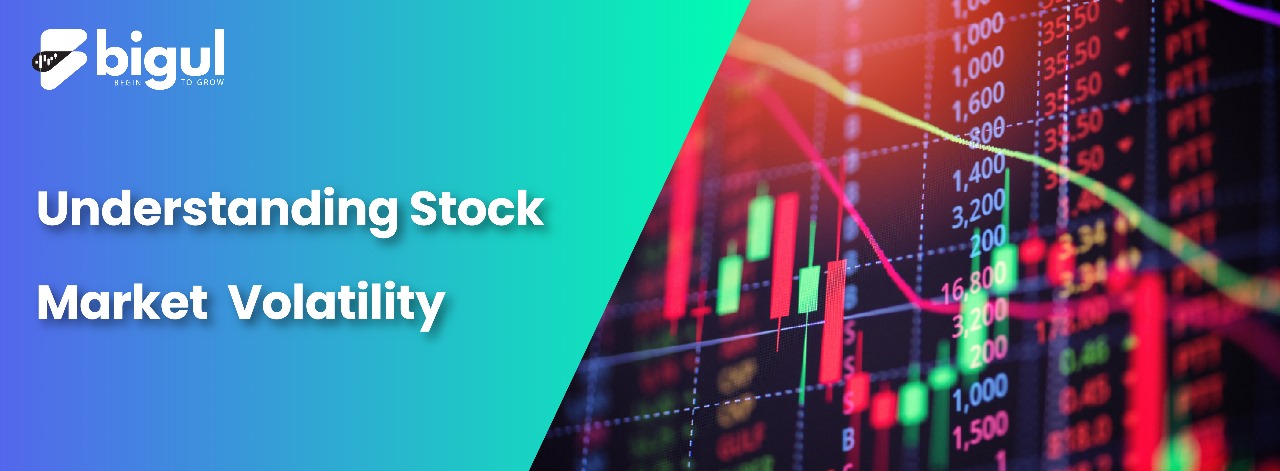Market volatility is a financial instrument’s price variation over a given period. Online trading relies on it to measure price movements. High volatility signifies rapid price changes, indicating increased uncertainty and risk.
On the other hand, lower volatility suggests more stable prices. Understanding market volatility is vital for traders as it directly affects their trading strategies and risk management.
Additionally, it influences investor sentiment, as periods of high volatility can trigger fear or excitement, impacting market behaviour.
This article explains market volatility’s impact on the stock market and investor feelings. Let’s start by grasping what market volatility means in simple terms.
What is Stock Market Volatility?
Volatility, in simple terms, is how fast a security’s price goes up or down based on its returns. It shows how risky it is due to price changes. People measure it by finding how much the returns differ from the average over a certain time.
This is called “standard deviation.” Basically, it checks how quickly a security’s or market’s value moves.
Two main ways to measure it: standard deviation and variance. Bigger numbers mean bigger price changes. A high standard deviation means prices spread widely, and low means they stick to a tight range.
For stocks, quick price changes – up or down – show volatility. A big standard deviation means prices can change a lot. A rise or fall of 1% in market numbers usually means a “volatile” market.
Remember, volatility isn’t just one thing. It’s complex and has many sides.
Factors Influencing Stock Market Volatility
Stock market volatility is influenced by a combination of various factors, ranging from economic indicators to market sentiment.
Here are some of the key factors that can influence stock market volatility:
- Economic Data Releases: Economic data releases, including GDP growth, unemployment rates, inflation, and consumer confidence, significantly impact stock market volatility.
- Positive or negative surprises in these indicators can trigger market fluctuations as investors adjust their expectations and investment strategies based on the health and outlook of the economy.
- Interest Rates: Interest rates set by central banks influence borrowing costs and investment decisions. Lower rates encourage borrowing and spending, potentially boosting stock prices. Conversely, higher rates deter borrowing, impacting stock prices negatively. These rate changes influence market sentiment, contributing to stock market volatility as investors react to shifts in economic conditions and central bank policies.
- Geopolitical Events: Geopolitical events, such as conflicts, trade tensions, and political instability, introduce uncertainty to the stock market. This uncertainty triggers changes in investor behaviour and sentiment, leading to heightened stock price fluctuations. Geopolitical factors can amplify market volatility as investors respond to unpredictable global developments that impact economic and business environments.
- Market Sentiment: Market sentiment, reflecting the collective outlook of traders, significantly impacts market volatility. When widespread optimism or pessimism prevails, it drives increased market activity and price fluctuations. The late 1990s dot-com bubble exemplifies this, as optimistic views on tech companies fueled demand for their stocks, intensifying market volatility. Market sentiment’s influence on investor decisions and subsequent market dynamics showcases its role in driving short-term fluctuations and shaping overall market stability.
- Global Economic Conditions: Global economic conditions, including the growth of major economies, global trade dynamics, and currency exchange rates, significantly impact stock markets worldwide. These conditions can spark fluctuations and heightened volatility as they influence investor sentiment, trade patterns, and cross-border financial flows.
Movements in these macroeconomic indicators can prompt shifts in market trends and amplify price changes across various stock exchanges, contributing to dynamic market behaviour.
Measurement of Stock Market Volatility
Volatility, the swift fluctuation of stock prices, can be tracked using several metrics that help investors understand and manage risks effectively.
- Standard Deviation: One common method is through standard deviation, a statistical tool that gauges the dispersion of stock returns from their average over a specific period. A higher standard deviation indicates more price swings, reflecting increased volatility. This technique provides a historical perspective on how wild price movements have been in the past.
- Volatility Index (VIX): The Volatility Index, commonly known as the VIX, quantifies market sentiment and future volatility expectations. Referred to as the “fear index,” it assesses options prices and indicates investors’ anticipation of market turbulence. A higher VIX signifies greater anticipated volatility.
Historical vs Implied Volatility
Another approach distinguishes between historical volatility and implied volatility.
Historical Volatility: Historical volatility gauges volatility over time using past returns or prices, relying on scientific measures. It helps investors assess how security performs based on its underlying asset’s past price movements.
Increasing historical volatility means bigger price swings while decreasing volatility indicates steadier prices around the average. It’s a tool to anticipate future fluctuations based on past behaviour.
Implied Volatility: Implied Volatility is a measure that reflects the market’s expectation of how much a stock’s price might change in the future. Derived from option prices, it indicates investors’ collective anticipation of potential price swings.
Higher implied volatility suggests greater expected uncertainty, while lower values indicate relative stability. This metric is essential for options traders, helping them assess the potential risk and reward of their trades based on market sentiment.
Strategies for Navigating Volatile Markets
Navigating volatile markets requires a combination of careful planning, risk management, and adaptability.
Here are some strategies to consider:
- Diversification: Spread investments across various asset classes to reduce risk.
- Active Monitoring: Stay informed about market trends and news to make timely adjustments.
- Long-Term Focus: Maintain a solid investment plan aligned with your goals despite short-term fluctuations.
- Cash Reserves: Hold a portion of funds as cash to seize opportunities during market downturns.
- Risk Management: Set stop-loss orders and employ hedging strategies to limit potential losses.
There are many ways investors can handle these volatilities. One of the best ways is to Diversify. Diversifying their portfolio across different asset classes, industries, and regions is the best way investors can handle volatility.
This strategy helps spread risk and minimize the impact of sudden market fluctuations, ensuring a more stable long-term investment approach.
Conclusion
Grasping the nature of stock market volatility is essential for investors. It is an inherent aspect of financial markets, driven by various factors like economic indicators, geopolitical events, and investor sentiment. While volatility can be unsettling, it also presents opportunities.
A well-informed and diversified approach, coupled with a focus on long-term goals, can empower investors to navigate and potentially benefit from market fluctuations.

.jpg)






.jpg)
.jpg)
